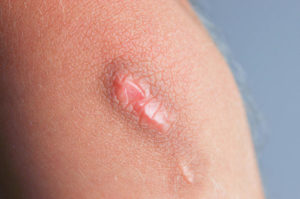Corona Bedsore and Pressure Sore Lawyer
Bedsores, also called pressure sores or decubitus ulcers, are preventable wounds that can develop on bedridden patients when they aren’t getting adequate care.
The health complications caused by bedsores are so serious that all nursing facilities, hospitals, and other long-term facilities in Corona have protocols in place to avoid this condition. Along with being an essential part of caregiving, preventing bedsores is also required by both federal and California law.
Without adequate treatment, pressure sores can lead to sepsis, osteomyelitis, limb amputations, and even death. This type of injury is also excruciatingly painful, causing these vulnerable bedridden patients a great deal of unnecessary suffering.
For all these reasons, finding out your loved one has developed a bedsore while being treated at a facility is a devastating experience. The personal injury attorneys at Yarian Accident & Injury Lawyers have years of experience resolving bedsore cases in and around Corona. We understand the seriousness of this situation and can help you get justice.
Attorney for Bedsores & Pressure Sores in Corona, CA
All patients deserve caregivers that pay attention, understand the factors that create bedsores, and will take steps to prevent them.
The attorneys at Yarian Accident & Injury Lawyers have more than two decades of experience advocating for victims of medical negligence and elder abuse.
We know the heartbreaking consequences that can happen when medical professionals fail their basic duties.
One of our recent bedsore cases involved an elderly gentleman that went to the hospital for routine surgery, didn’t receive adequate care during his recovery, and developed a severe pressure ulcer that led to getting his leg amputated. Our firm proved the hospital’s negligence and secured a $410,000 payout for the client.
Past results are no guarantee of future results as all cases are unique, but Yarian Accident & Injury Lawyers is proud of our team of knowledgeable, skilled attorneys that can fight vigorously for your rights and help you get fair compensation. Call 844-291-1911 or submit the online contact form to let us know about your case.

How Pressure Sores Form

Bedsores develop when there’s too much pressure on the skin over a long time, usually from lying or sitting in the same position. This type of injury is especially common on the buttocks or the tailbone, where a lot of the bedridden patient’s body weight will be centered.
Sores can also form
- On the heels of the feet
- The back of the head
- Elbows
- Around the knees
- The hips
Placing constant pressure on these areas is damaging because it obstructs the normal flow of blood from being able to reach there. Eventually, the skin and tissues in these compressed spots will begin to wither away and die from lack of oxygen.
Why Bedsores Are a Sign of Negligence
Health care professionals know that bedridden patients have an extremely high risk of getting a pressure sore. Whether they’re elderly, in poor health, or have a spinal injury, these vulnerable patients will need help changing positions regularly. Their skin also needs to be monitored for signs that a pressure sore may be forming.
This is especially true for bedridden patients that also have some of the other major risk factors, such as:
- Poor Sensation: There are neurological issues and other conditions that reduce the patient’s ability to feel sensations. They can’t feel the warning signs that there’s too much pressure on a certain area, which is the body’s natural hint to shift positions.
- Inadequate Blood Flow: Conditions like vascular diseases or diabetes increase the likelihood of bedsores because they reduce blood flow, making it harder for oxygen and nutrients to circulate throughout the body.
- Incontinence: Having poor bladder control is very hard on the skin, especially if it’s exposed to urine for extended periods. Bedsores are more likely with weak and irritated skin.
Federal law requires nursing homes and other facilities to follow a standard protocol at the very first signs that the skin is beginning to break down and a pressure sore is forming.
These techniques include
- A repositioning schedule to move the patient every two hours, avoiding prolonged weight on the sore
- Incorporating tools like air mattresses, foam wedges, and cushions to relieve pressure
- Keeping clothing and bedding as clean and dry as possible
- Improving the patient’s nutrition and hydration to help the skin rebuild
- Prescribing antibiotics, if necessary
- Cleaning the wound and dressing it in medicated gauze
- Regularly assessing and documenting the size, depth, and severity of the sore, to see how it responds to treatment
The Stages of Bedsores
Pressure sores that aren’t treated according to the proper guidelines will get bigger, deeper, and more infected over time, leading to life-threatening complications. This is a process that doesn’t happen overnight, and it shows a consistent pattern of neglect on behalf of the patient’s caregivers.
Stage 1
The beginning of a pressure sore is just an area of red skin on one of the body parts that is known for developing these injuries. While the damage is just superficial at this stage, caregivers need to begin the bedsore protocol and stop the problem from getting worse.
Stage 2
The wound now has open sores and blisters forming on the skin, while the surrounding tissues are discolored and irritated. There can be no doubt a bedsore has formed, and that the wound is growing both bigger and more severe. Caregivers that don’t follow bedsore protocol are being negligent. They’re also required to begin documenting their efforts to treat the injury.
Stage 3
The bedsore damage now extends down to the tissues, causing the skin to sink into a deep, open crater. At this point, the area is so damaged that it may be possible to see the patient’s muscles and fat tissues.
As the skin continues breaking down, the patient may contract potentially fatal bacterial infections, like sepsis, an infection that begins on the injury site but then spreads throughout the body via the bloodstream
Stage 4
The most advanced stages of a bedsore will result in catastrophic damage, with dead tissue that reaches deep down into the bone, tendons, and joints. The patient can also potentially develop osteomyelitis, an infection that attacks the bone and spreads into the bone marrow.
Bedsores at this stage are extremely hard to treat and very likely to be fatal, even if there is finally an aggressive medical intervention. The patient is likely to spend the rest of their lives in great physical pain.
Who Can Bear Liability for Bedsore Injuries?
The bottom line is that serious bedsores are preventable with proper attention. When you place your loved one in a nursing home or hospital, it’s because you trust these medical professionals to provide a certain level of care. The formation of a pressure sore is graphic evidence that the facility failed in its duty of care.
If a facility failed to take adequate steps to treat this injury during the early stages, victims may pursue compensation from the facility, employees, and any other responsible parties. If the pressure wound causes the patient’s death, the victim’s family members are entitled to file a wrongful death suit.
Some of the duty of care violations that would make a facility liable are:
- Not assessing the patient for the likelihood of developing a pressure sore, despite at least one major risk factor
- Not regularly inspecting the skin for signs that a bedsore was forming
- Not turning or repositioning the patient every two hours, either to prevent bedsores from forming or to treat one that has already formed
- After seeing a bedsore, not creating a treatment plan, or not adhering to the plan that was created
- Not coordinating with the right medical personnel about treating a bedsore, such as a hospital that offers more advanced care
- Not closely monitoring and documenting the bedsore
- Not bathing, cleaning, or changing soiled undergarments as often as they should
- Not providing a nutritious diet or enough hydration
Along with these critical care factors, facilities are also evaluated for how well they manage their staff.
This includes
- Having an acceptable staff-to-patient ratio, ensuring that there are always enough caregivers to meet the needs of every patient
- Hiring skilled staff and then providing proper training
- Having a bedsore protocol in place
- Monitoring staff to make sure they’re providing patients with a good level of care
According to the law, any facility that doesn’t implement a treatment plan during the early phases of a pressure sore can be held responsible for the extreme complications that follow.
The Types of Compensation Available for Bedsore Cases in Corona
Victims of advanced bedsores describe the experience as physical agony. Those that manage to survive will often deal with lifelong consequences, such as limb amputation. Pursuing legal action against neglectful facilities is a way to get compensation for these damages, but it’s more than that. Bedsore lawsuits are also important for drawing attention to the problem, ensuring that facilities will make changes and provide better care for patients.
Depending on the severity of the victim’s pressure sore, and the permanent harms caused by complications, the main types of compensation they can pursue are:
#1. Economic Costs
Patients with an advanced bedsore will need very expensive medical care to survive the complications of this injury. Beyond the immediate crisis to help the patient recover, patients will also often need ongoing treatment as a direct result of getting a bedsore. For example, patients with an amputated limb may need ongoing physical therapy or have to install home modifications to accommodate their new disability.
Patients that are still in the workforce are also eligible to seek compensation for lost wages or for being permanently disabled.
#2. Pain and Suffering
The courts also recognize the non-economic costs of getting a bedsore due to the negligence of caregivers. Pressure ulcers are extremely painful and take a very long time to heal. Patients with this injury have a dramatically reduced quality of life, experience a great deal of anguish over their health crisis, and also have to deal with permanent scars.
#3. Wrongful Death
Some patients with pressure sores will end up paying the ultimate price for not getting an adequate level of care. The family members of these victims can sue for wrongful death, which is the legal term for a preventable death that was caused by negligence or misconduct.
#4. Punitive Damages
In cases where the evidence points to a facility being extremely negligent and reckless, the courts may award victims an extra form of compensation called punitive damages. This compensation punishes the liable parties and hopefully prevents other patients from suffering the same conditions.
Hiring a Corona Bedsore Lawyer

By law, nursing homes and hospitals are required to provide patients with a decent level of care, which includes the proper attention and treatment to prevent bedsores or stop them from becoming critical. While facilities that don’t meet these standards are liable for damages, victims will still need strong evidence to prove a successful claim.
That’s because the insurance companies of these medical organizations use sophisticated strategies to get out of liability or minimize their role in compromising the patient’s health. The process of proving that a facility’s neglect is not easy and requires the right legal approach.
Yarian Accident & Injury Lawyers have the resources, skill, and drive to build a strong case for bedsore victims in and around Corona.
The statute of limitations for bedsore lawsuits in California is:
- One year from the injury if the case involves medical malpractice
- Three years, otherwise
Reach out to Yarian Accident & Injury Lawyers today at (951) 523-0000 to begin investigating your bedsore case.
Yarian Bedsore and Pressure Sore Lawyer Corona, CA Office Location
1611 Pomona Rd #222Corona, CA 92878
Phone: +1 951-523-0000








